
The main vege beds - lots of growth in most of the beds, with a couple cleared and being prepped for new planting. The old brassicas are all gone now.
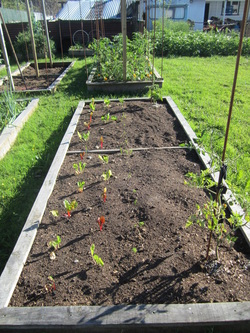
I also transplanted some parsley seedlings down the middle, from another bed I was clearing so my daughter could grow some veges. Parsley does not like to be transplanted, but I figured I may as well give it a go, since otherwise they were going to be tossed out. As expected, most of the existing leaves died, but new ones were sprouting from some of the transplants. A week later, after quite a bit of rain, as I'm writing this, ALL the transplanted parsley is putting up new shoots.
I have also planted two tomatoes so far in this bed - a Russian Red and a Sweet 100 bought from a church market sale. The rest of the space will shortly be filled with Tiny Tim tomatoes.

Spring onion flowers being enjoyed by the bees. Flowering lettuce not yet ready to be removed (for seed). Still haven't pulled out the leeks in the back half.
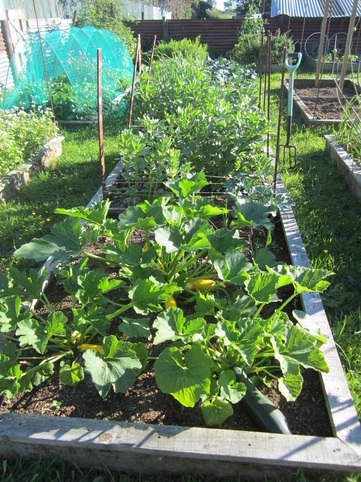
Behind the zucchini are some shallots growing slowly, and one broccoli plant which I'll mention again in a moment.
In the back half of the bed are broad beans, which are doing well. The spinach I planted between the rows has not done well, however - all but two have been dug up by birds or otherwise failed. A small nasturtium I put in is just starting to flower.
I've never grown broad beans before - next time I would put them somewhere they can grow around the outside of a structure that will give them plenty of support. It's also a bit of a trick learning when is the right time to harvest the beans.
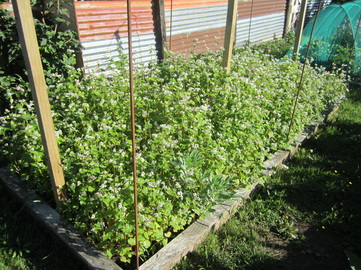
The flowers are tiny but pretty. Definitely attracting lots of pollinators.
This bed will be planted in Roma tomatoes.
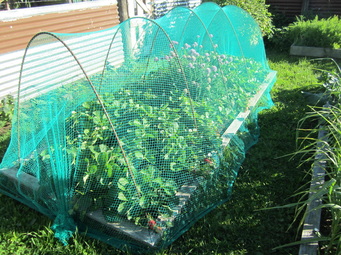
It is important to feed the soil around heavy-producers as the season goes on, if you want production to continue well.

Results so far: The plants are noticeably thriving - the ones in this bed are much, much bigger than the "control plant" put in another bed (behind the zucchini). They are just starting to form heads. I have discovered only 2 or 3 white butterfly caterpillars on them so far, in the entire bed, (which I squished). So not completely free of them, but not overwhelming numbers like I've dealt with in the past. There have been small populations of aphids and whitefly on the leaves - I simply "rub them out" with my gloved hands. It looks like, a few pests aside, I might actually succeed in growing broccoli for summer eating this year!


I forgot to write down exactly how I did this (you always think you'll remember these things, but then never do!), but this bed was either prepped with, or the tomatoes had added to their planting holes: compost, Rok Solid, sheep pellets, blood and bone, and Dolomite. Dried, crushed egg shells were later sprinkled under each tomato plant on the soil surface too. Everything looking good so far. I've written more about growing tomatoes HERE, and will also post more as the season progresses.

After prepping and planting her bed, she came and told me maybe gardening is kind of fun after all. ;-)
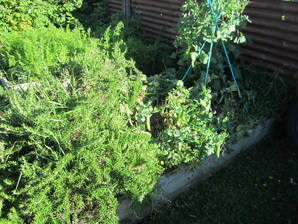
The rosemary at the front is due to be moved. I also learned recently that they should be regularly pruned, so avoid them becoming too woody (it's the fresh green growth that is used in cooking etc). So I will move it and prune it. It's not flowering right now, so it's probably a good time to do this.
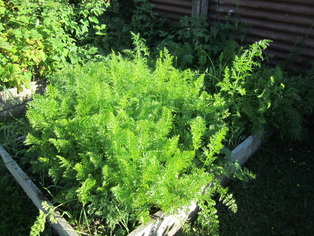
And boy, they taste good!!
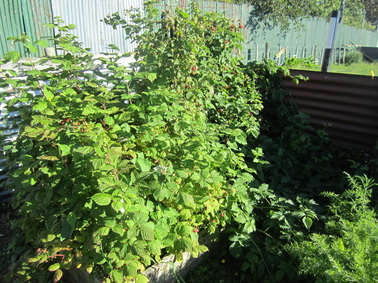
The bees have been absolutely LOVING the flowers of the berries - raspberries, boysenberries, blackberries and strawberries. Strictly speaking, berries don't NEED bees for pollination (they are self-fertile and can be wind pollinated), but bees do improve pollination. In some ways, I think the bees need the berries more than the berries need the bees, and for this reason I would recommend planting a berry patch to all gardeners, even if they don't want berries for themselves. (Though who doesn't love fresh summer berries??)

Borage is apparently the ideal companion for strawberries, greatly increasing their yield. I didn't know that when I planted my strawberry patch, and anyway they grow so big they wouldn't have fitted under the netting I have over the patch. In this bed is as close as I can plant them to the strawberries, so hopefully they will do some good there anyway.

I noticed last year that my red currant LOATHES tap water - hoping to only water it with rainwater this year.
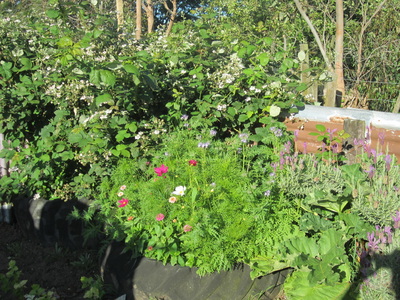
Last summer, as regular readers will know, was my first attempt at the vege garden. I saw very few honey bees all summer, but quite a lot of bumble bees (which pollinated my pumpkins, zucchini etc). So I started thinking about how to help and attract more bees (as well as other beneficial insects for pest control), and what to plant for that purpose. I started seeing more bees in June, when the red hot pokers in the paddock came into flower, followed by the lilacs. Shortly after, some of my brassicas went to seed, and I left them for the bees as I know they love those flowers. That seemed to get the ball rolling and they were visiting my garden looking for food. I had rosemary in flower over winter too. Meanwhile I started planting other things for the bees, and now I'm seeing a lot of honey bees and native bees, as well as bumble bees in my garden. Flowering right now I have blackberries (raspberries and boysenberries have just about finished), buckwheat, lavender, cosmos, phacelia, zinnia, marigolds, nasturtium, calendula, cucumbers, zucchini just getting going, potatoes, tomatoes, buk choy, spring onions, chives, lettuce, broad beans (peas have just finished), parsley, comfrey, borage is just starting, roses, lemon, geraniums, Sweet William, impatiens, and then other things that are coming along and will flower soon. In terms of pollination AND pest control, there is nothing so important as making room in your vege garden for some flowering plants! Ideally, you want a variety of plants flowering at all times, year round. I'm still learning how to plan for that, but it is my aim.


Along the fence I planted black currants, with mixed green and bright-lights silverbeet in between. Along the front are planted a mixture of green and yellow zucchini, and at this end are planted leek seedlings - I'm going to let that spot become a "perpetual bed" for the leeks.
I'm going to either underplant with red clover as a living mulch, or mulch the bed with some other materials - yet to be decided.
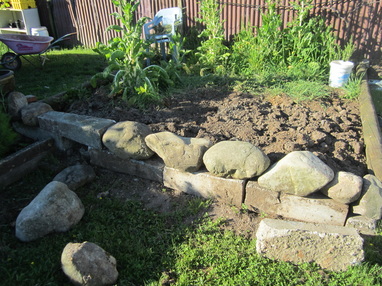
Now the chimney has been replaced with some concrete house-piles that were in the chicken run, and topped with large (heavy!) rocks that had been in the front garden, awaiting me figuring out how to make use of them. This is, obviously, a work in progress. My plan is to finish clearing it, plant a hedge of NZ Cranberry (Chilean Guava) - fragrant and delicious - right behind the rocks, create a path across the area behind that, and then put in the structure and seat, with a stauntonia climbing it, some peas against the fence behind, and a lemon verbena in the corner where those plastic chair are sitting, as there is a much-used gate to the paddock right there, and brushing against the lemon verbena will release it's gorgeous fragrance. I'm going to replace the two fence-post edgings with more concrete piles (as soon as another useful teenager or young man is available to shift them for me), and use the posts as part of the framework for the shelter/structure (don't really know what to call it) I plan to build. Add a few potted plants, and I think this is going to look great in time! Watch this space.

My first compost pile is almost finished, and will soon be spread on a garden bed. The second pile (in the third bin) is due to be turned. The grapevine is absolutely loaded with developing grapes; clearly I did manage to figure out the right way to prune it last winter. :-)
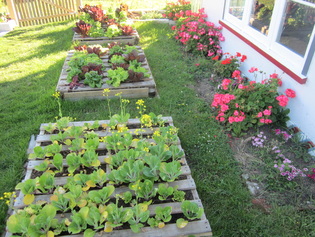

Right behind the brick squares I have sown a long strip of carrot seed, edged with young chive plants. Chives keep carrot fly away, and when this all grows in time, I think it will look really cool!

I'm hoping what's going on under the soil is as productive as what's happening above! The plants have been mounded up well once; I'm going to need to add mulch or similar soon to increase the mounding.
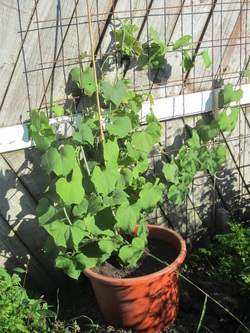

On the other fence (not pictured) my climbing rose is producing shoots, impatiens are flowering vigorously, and more parsley transplants are doing very well.

My greenhouse still has a lot of plants that will be planted out soon, and I have lots of seeds waiting to go in. More digging to do in preparation!

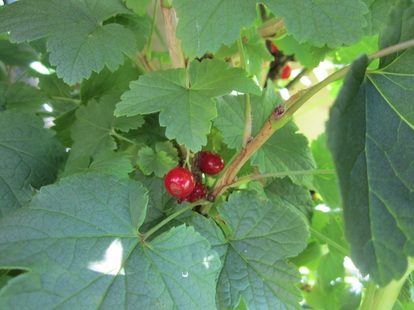
 RSS Feed
RSS Feed
